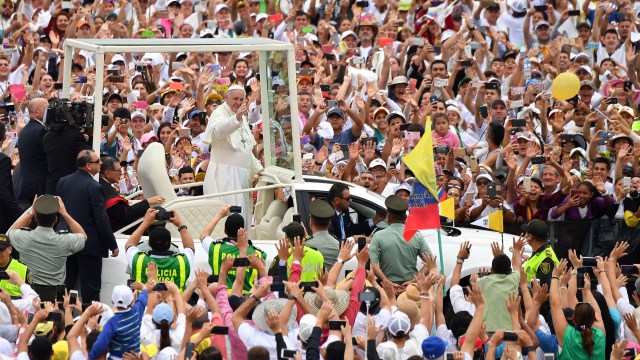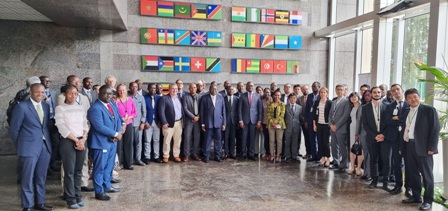Most view Pope Francis favorably, though his ratings have dropped
This Pew Research Center analysis explores views on the Catholic Church and Pope Francis among Catholics in Latin America and the United States.
All seven countries in the survey have Catholic populations that rank among the world’s 25 largest – notably including Brazil (largest), Mexico (second-largest) and the U.S. (fourth-largest) – according to the Vatican’s 2021 Statistical Yearbook of the Church. And the six Latin American countries surveyed account for roughly three-quarters of the region’s Catholics.
For non-U.S. data, this analysis draws on nationally representative surveys of 6,234 adults – including 3,655 Catholics – conducted from Jan. 22 to April 27, 2024. Surveys were conducted face-to-face in Argentina, Brazil, Chile, Colombia, Mexico and Peru.
In the U.S., we surveyed 12,693 respondents from Feb. 13 to 25, 2024, including 2,021 Catholics. Most of the survey’s respondents (10,642) – including all of the survey’s Catholic respondents – are members of the American Trends Panel (ATP), an online survey panel recruited through national random sampling of residential addresses, which gives nearly all U.S. adults a chance of selection. Read more about the ATP’s methodology.
The remaining respondents (2,051) are members of three other panels: the Ipsos KnowledgePanel, the NORC Amerispeak Panel and the SSRS Opinion Panel. All three are national survey panels recruited through random sampling (not “opt-in” polls). We used these additional panels to ensure that the survey would have enough Jewish and Muslim respondents to be able to report on their views. (While Jewish and Muslim respondents are not discussed in this particular report that focuses on Catholic topics, they are discussed in other reports based on this survey.)
The U.S. data is weighted to be representative of the U.S. adult population by gender, race, ethnicity, partisan affiliation, education, religious affiliation and other categories.
Here are the questions used for the report, along with responses, and the survey methodology.
This analysis was produced by Pew Research Center as part of the Pew-Templeton Global Religious Futures project, which analyzes religious change and its impact on societies around the world. Funding for the Global Religious Futures project comes from The Pew Charitable Trusts and the John Templeton Foundation (grant 63095). This publication does not necessarily reflect the views of the John Templeton Foundation.
A new survey by Pew Research Center asked Catholics in six Latin American countries and the United States how they think the church should handle a variety of matters related to contraception, the priesthood and sexuality. Among the main findings:
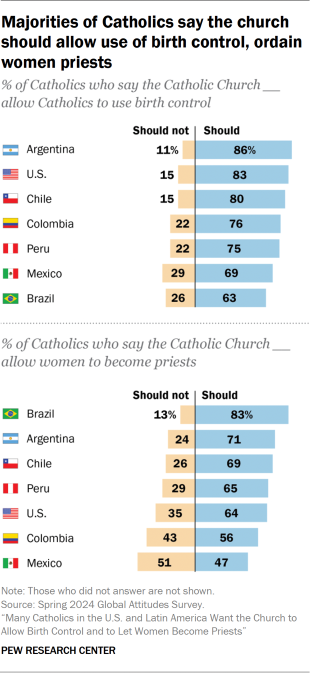
Most Catholics in all seven countries want the church to allow Catholics to use birth control. The shares saying this range from 86% in Argentina to 63% in Brazil.
In most of the countries surveyed, majorities of Catholics also say the church should allow women to become priests.
Opinion is more divided on whether the church should allow priests to get married. Roughly two-thirds of Catholics in Argentina, Chile and the U.S. are in favor, but majorities in Mexico and Peru say the church should not allow priests to marry.
Views on whether the church should recognize the marriages of gay and lesbian couples vary among Catholics in the countries surveyed. Majorities of Catholics in Argentina and Chile say the church should recognize the marriages of gay and lesbian couples, and just over half of U.S. Catholics agree. In the other four countries, fewer than half take this stance.
The survey also finds that Pope Francis, the first Latin American pope, remains broadly popular among Catholics across the region – though his favorability ratings are lower now than they were a decade ago, shortly after his papacy began in March 2013.
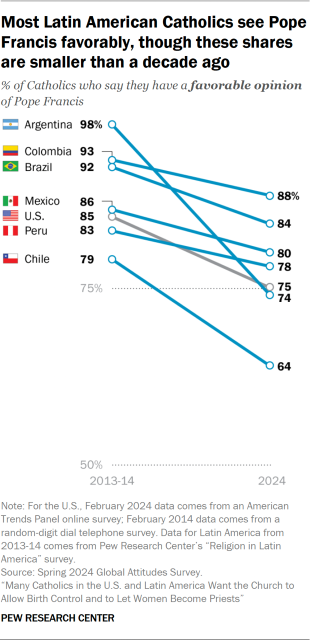
The decrease in favorability has been sharpest among Catholics in Argentina, his country of birth. Ten years ago, nearly all Catholics surveyed there (98%) expressed a favorable opinion of Francis, compared with 74% today.
And in the U.S., where a February 2014 survey found that 85% of Catholics viewed the pope favorably, 75% now take that view.
Most Catholics surveyed also say Francis represents a change in the Catholic Church’s direction, with more of them calling it a major change than a minor one.
These are among the key findings of a survey of 5,676 Catholics, conducted in English, Spanish and Portuguese from January through April 2024 in seven countries: Argentina, Brazil, Chile, Colombia, Mexico, Peru and the U.S.
The rest of this report explores these findings in more detail.
More than a dozen of our surveys have measured U.S. Catholics’ favorability toward Pope Francis since the start of his papacy. Find this more detailed U.S. trend in our recent report, “Majority of U.S. Catholics Express Favorable View of Pope Francis.”
How we worded these questions
We used simple, common phrases in the survey questions about some steps that Catholics would – or would not – like to see the church take. Our goal was to make the questions easy to understand for as many respondents as possible. In some cases, the wording of the questions involved a trade-off between broad understandability and theological nuance.
For example, one question asks whether the church should “allow priests to get married.” This would not, strictly speaking, be a change in doctrine. The Catholic Church already allows married priests under certain circumstances, such as if a man was married before being ordained in an Eastern Catholic Church. Technically, the church considers the rule of celibacy for priests to be a “discipline” rather than a doctrine. Nonetheless, allowing parish priests to get married and continue in their duties would represent a big change in the everyday life of the church in the United States and Latin America.
Similarly, another question asks whether the church should allow unmarried Catholics who “are living with a romantic partner” to receive Communion. Actually, Catholicism has no rule against unmarried people living together. The church’s teaching is that sexual activity outside of marriage is a grave sin, and that anyone “conscious of a grave sin” should not take Communion unless they have been to confession.
Yet another example concerns contraception. The survey asks whether the church should allow Catholics to “use birth control.” But the church does not object to married couples using natural methods (i.e., abstaining from sex during fertile periods) to “space the births of their children.” Rather, the objection is to using methods that prevent the sexual act from resulting in conception, including “condoms, hormonal birth control pills and sterilization.”
Views of Pope Francis
In every Latin American country surveyed, as well as the United States, approximately two-thirds or more Catholics express a favorable view of Pope Francis, including 88% in Colombia and 84% in Brazil.
Related: How people in Latin America and the U.S. view Pope Francis
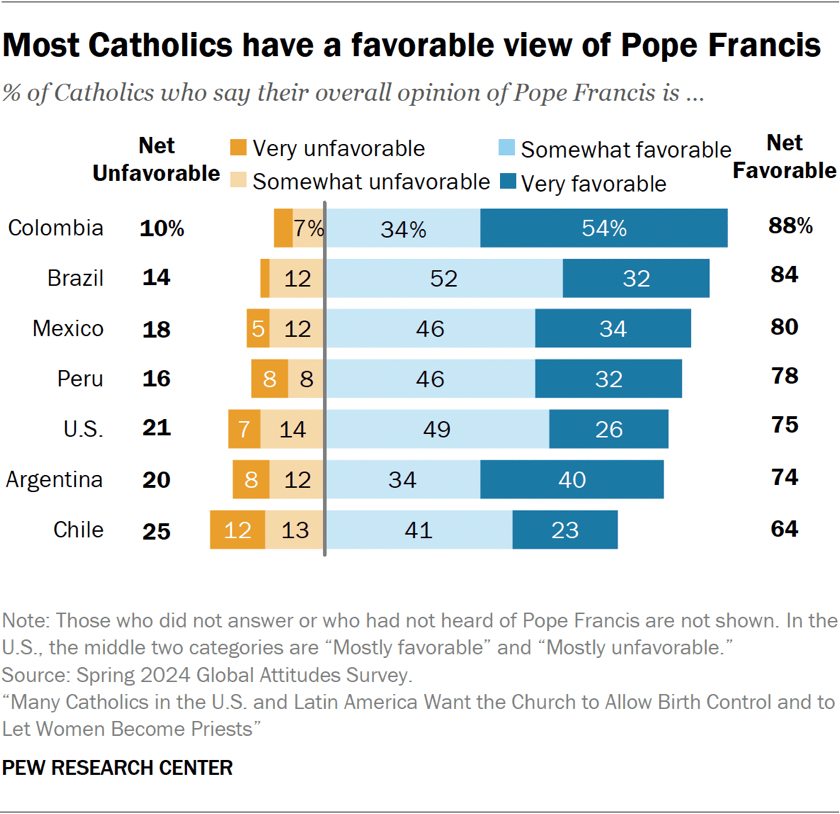
Colombia is the only country surveyed where at least half of Catholics express a very favorable view of Francis. In the other countries, these shares range from 40% in Argentina to 23% in Chile.
Catholics who pray daily generally are more likely than those who pray less frequently to hold a very favorable view of Francis. For example, 40% of Mexican Catholics who pray daily say they view the pope very favorably, compared with 29% of other Catholics.
Pope Francis as a source of change in the church
Most Catholics surveyed say Pope Francis represents a change in the Catholic Church’s direction. And they are more likely to say this is a major change than a minor change.
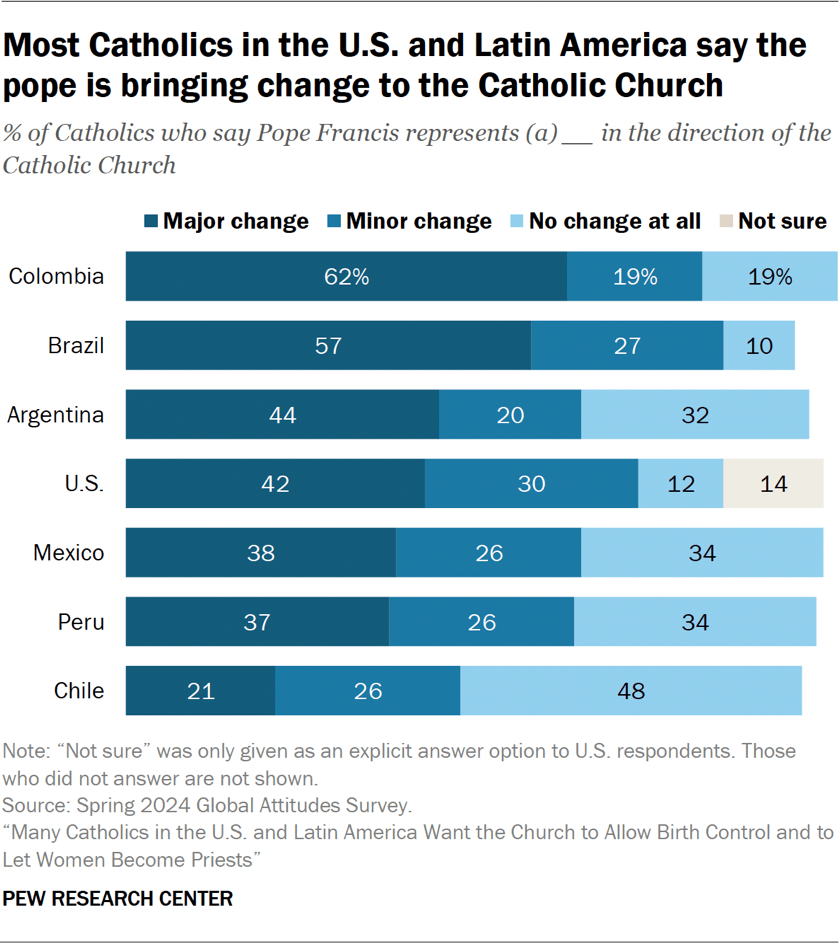
For example, in Colombia, 62% of Catholics say that he represents a major change in the church’s direction, while just 19% say he is a minor change. Another 19% of Colombian Catholics say he represents no change at all for the church.
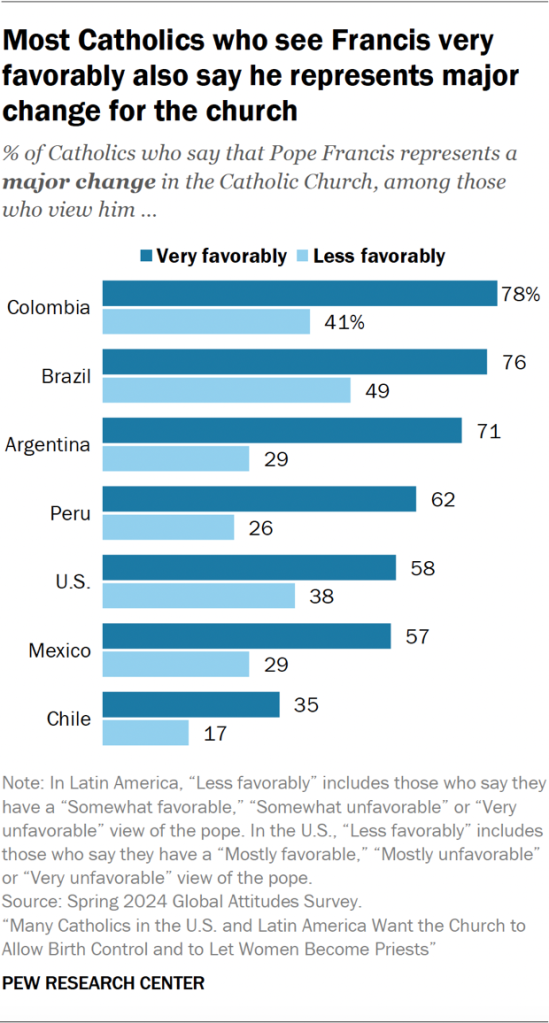
Chilean Catholics, who tend to be less favorable toward Francis than Catholics in other surveyed countries, also stand out on this question. Nearly half say that Francis has not changed the church’s direction, and the rest are divided on whether he has been a major (21%) or minor (26%) change for the church.
The view that Pope Francis represents a major change is especially strong among Catholics who say they have a very favorable view of him.
For example, 62% of Peruvian Catholics with a very favorable view of the pope also say he represents a major change in direction for the church, while 26% of Peruvian Catholics who view Francis less favorably say this.
Views on the priesthood, contraception and sexuality
On balance, most Catholics in Latin America and the U.S. say the Catholic Church should allow Catholics to use birth control, allow women to become priests and allow cohabiting couples to receive Communion.
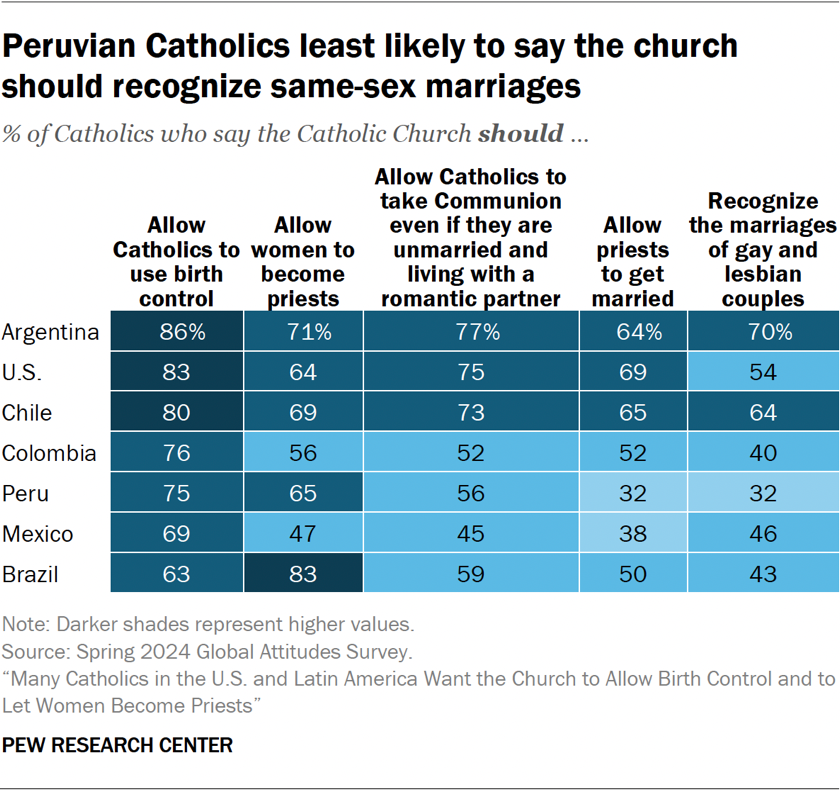
Catholic opinion in the countries surveyed is more divided on whether the church should let priests marry and whether it should recognize the marriages of same-sex couples. Catholic majorities in Argentina, Chile and the U.S. want the church to take both of these steps, while a majority of Peruvian Catholics do not want the church to take these steps.
Similarly, most Catholics in Mexico do not want the church to allow priests to get married, and a majority of Catholics in Colombia do not think the church should recognize marriages of same-sex couples.
Views by measures of religiousness
In general, Catholics who pray daily are less likely than other Catholics to say the church should take these steps. For example, 55% of Brazilian Catholics who pray daily say the church should allow Catholics to take Communion even if they are unmarried and living with a romantic partner. Meanwhile, among Catholics in Brazil who pray less often, 75% say this.
Due to small sample sizes of Catholics who say they attend church weekly or more often, we are unable to show the differences in opinions on these survey questions between frequent Mass attenders and other Catholics in all the surveyed countries.
However, in countries where the samples are large enough to allow reliable analysis, the broad pattern is similar to daily prayer: More traditionally observant Catholics are less likely to favor these ideas. In Mexico, for instance, 38% of Catholics who attend church at least weekly think the church should recognize gay and lesbian marriages, but among other Catholics, 52% say this.
Views by age
Across Latin America, younger Catholics are more likely than others to say the church should take these steps.

In Colombia, for instance, 65% of 18- to 39-year-old Catholics think the church should allow women to become priests. Among older Colombian Catholics, 49% take this position.
Views over time
We also asked several of these questions in our survey of religion in Latin America a decade ago, and in surveys of U.S. Catholics conducted around the same time.
The shares of Latin American Catholics who say the church should allow women to become priests have risen. In Argentina, these shares increased from 51% in 2013-14 to 71% in 2024, while in Mexico they increased from 31% to 47% over the same period. In the U.S., however, attitudes on this question among Catholics are in the same ballpark as they were a decade ago.
Views about the church allowing Catholics to use birth control have held fairly steady over the decade in most of the countries surveyed. The largest swings recorded in either direction were among Catholics in Peru (a 12 percentage point increase in wanting the church to take this step) and in Brazil (a 12-point decrease).
Meanwhile, the shares of Catholics who say the church should allow priests to get married have remained relatively stable in the surveyed countries.
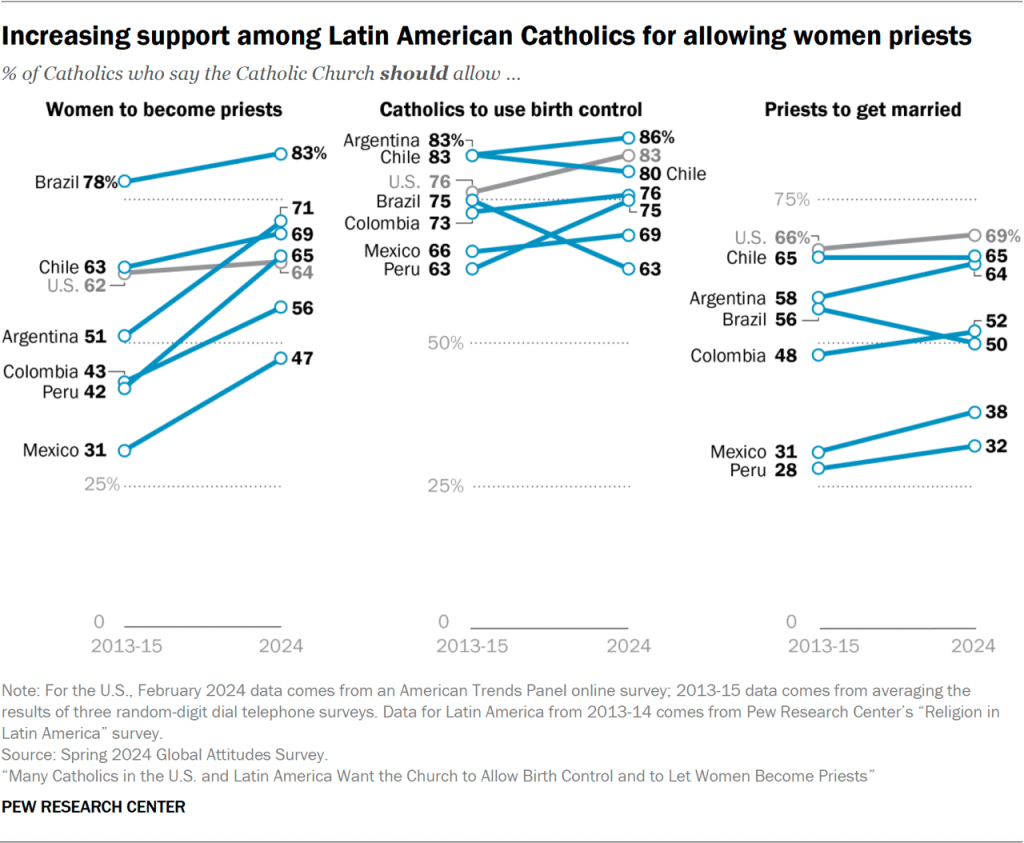
For more information on how attitudes on these issues have changed over time among U.S. Catholics – including the individual data points for all three surveys from 2013-15 that asked some of these questions – refer to our recent report, “Majority of U.S. Catholics Express Favorable View of Pope Francis.”

